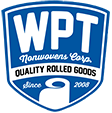WPT nonwoven viscose rayon fabric is made from 100% rayon filament or rayon blend. Made from natural fiber derived from wood pulp. Viscose Rayon Nonwoven Characteristics Rayon nonwoven offers the characteristics of high absorbency, softness, and comfortable finish. Since it is easy to dye, a wide palette of nonwoven color options can be specified for… Read more »
Posts Categorized: Nonwoven Fabrics
Why Nonwovens are the Most Customizable Fabric Option
One of the best advantages of using nonwoven fabric is that it is highly customizable. This is a very important attribute for specialty applications such as adult diapers and feminine hygiene products. These personal care items require characteristics such as strength, absorbency, and softness on the skin. The nonwoven manufacturing process provides many options for… Read more »
Why Choose Bicomponent Nonwovens?
Nonwoven fabrics have become the material of choice for making a variety of innovative products that are convenient and cost-effective. Various fabric treatments and fabrication materials are used to construct nonwovens, including cotton, viscose, and polyester. One type of nonwoven that has grown in popularity is bicomponent fiber nonwoven fabric. How Bicomponent Nonwovens Are Made… Read more »
Don’t Trust Your Supply Chain Stability to Overseas Nonwovens Suppliers
For purchasing departments, there can be a strong temptation to look solely at price when comparing suppliers. Price is important, but if the materials are of poor quality or availability suddenly becomes a problem, you could actually lose money by going with a cheap supplier. Overseas Suppliers Increasing Becoming Less Reliable Last year, as the… Read more »
How to Choose The Right Fiber for Your Nonwovens
Manufacturers who wish to use nonwoven fabrics for their products have a wide range of fiber options. For some applications, natural fibers like cotton are a good choice, but for others, a synthetic fiber such as polyester, might provide better attributes. When selecting fibers, it is important to consider the characteristics of a given fiber… Read more »
What is Through Air Bonding?
Through air bonding creates a versatile nonwoven product that has the benefit of being lightweight and safe for the environment. Through air bond nonwovens are used to create durable end use disposable products such as: Hygiene Products Filtration Materials Bedding & Furniture Personal Wipes Cleaning Wipes Dryer Sheets Baby and Adult Diapers And More The… Read more »
Nonwoven Polyester Fabric: Strong, High Density, & Durable
A synthetic material derived from petroleum, polyester is one of the most commonly used fabrics due to its versatility. It is typically soft, but offers the advantages of strength, high density, and durability. Nonwoven polyester is the ideal material for a wide range of application needs including industrial filter materials, medical and hygiene products, construction… Read more »
Nonwoven Rayon Fabric: Soft, Absorbent, & Comfortable
Rayon nonwoven fabric is made from natural fibers developed from wood pulp. WPT produces nonwoven rayon fabric from 100% rayon filament or rayon blend. Desired for characteristics such as high absorbency, softness, and comfortable finish, nonwoven rayon is easy to dye, so a wide range of color options are available. WPT Nonwovens supplies nonwoven rayon… Read more »
Why WPT Nonwovens Is the Name to Trust for Custom Nonwovens
Successful product development begins with selecting not only the right materials, but also the right supplier for your materials. When it comes to nonwoven fabrics, optimal product quality and performance often is achieved with custom nonwoven fabric, developed by a knowledgeable and experienced nonwovens manufacturer. The WPT Nonwovens team creates a diverse range of custom… Read more »
Bicomponent Nonwovens – The Customizable Nonwoven Fiber
Bicomponent fibers offer an innovative way to create nonwoven fabric that is essentially customized for a particular application. A bicomponent fiber is made up of two individual components distributed over the full length of a finished fiber. They can be from the same polymer or completely different polymer types. When different polymer types, an entirely… Read more »
